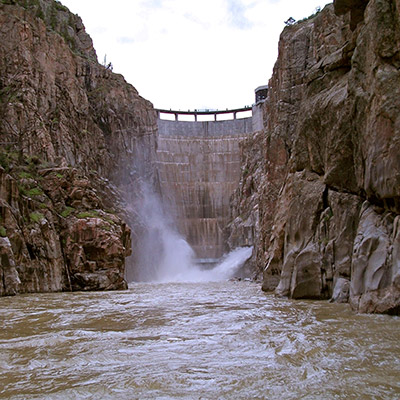Bighorn Irrigation
 Flood irrigation turns a barren landscape green
Flood irrigation turns a barren landscape green
Without irrigation, the dry plains of northwest Wyoming and southern Montana would be barren—brown, desolate and covered in wind-blown sage. But a series of flood irrigation projects that deliver mountain water to the plains below has transformed the Bighorn Basin into a rich agricultural area, while providing wetlands for recreation and wildlife.
The Shoshone Project in the Cody area is the largest project, supplemented by smaller projects throughout the mountain ranges surrounding the Basin.
The Shoshone Project
Operated by the Bureau of Reclamation, the Shoshone Project includes two major features in the Absaroka Range—the Buffalo Bill Dam and Buffalo Bill Reservoir. The massive concrete 350-foot, arch-gravity Buffalo Bill Dam on the Shoshone River was the vision of “Buffalo Bill” Cody, who founded the nearby town of Cody and owned much of the land now covered by the Buffalo Bill Reservoir. It was built in the early 1900s, and opened in 1910 as the world’s largest dam. The Buffalo Bill Reservoir is one of the largest in Wyoming, containing a 100-year-supply of irrigation water for the region.
Other features of the Shoshone Project include the Shoshone and Heart Mountain power plants and associated transmission facilities, and a network of tunnels, smaller dams and reservoirs, canals and laterals to deliver water to the project lands. Water from the Shoshone River is diverted into four irrigation divisions in the Cody and Powell areas:
- Garland Division
- The Corbett Dam and 17,355-foot tunnel diverts water to the Garland Canal. The Garland Canal is 18.5 miles long and has 260 miles of distribution laterals, 360 miles of open and closed drains, and numerous concrete control, check and drop structures supplying irrigated water to 700+ farms. The earthfill Ralston Dam and reservoir within the Garland Division are no longer used for irrigated storage, serving instead as an emergency waste route during storms. Work on these projects finished in 1908.
- Frannie Division
- Water supplied to the earthfill Deaver Dam and reservoir is diverted at the Corbett Dam, and flows through the Garland and 44-mile Frannie Canals. It was finished in 1922.
- Willwood Division
- The Willwood Dam and reservoir is on the Shoshone River. A tunnel from the dam diverts water into the 25-mile Willwood Canal, which delivers water to about 11,500 acres. It was finished in 1925.
- Heart Mountain Division
- An impressive 12-foot, 2.8 mile conduit excavated directly through the mountain diverts water from the Shoshone River into the Heart Mountain Canal. The Heart Mountain Division added another 26.2 miles to the Shoshone Project’s canal system. Work on the canal finished in 1947.
Corrugation, flood irrigation
At the farm, growers use corrugation irrigation to flood irrigate fields. Corrugating irrigation uses small furrows, called corrugations, to guide water across a field. The corrugations are added after the barley has been planted. When the barley needs watering, the grower contacts the irrigation district. Water is then delivered to canals running along the fields, and the grower diverts the water using siphons or lock and gate pipes. In northwest Wyoming, where rainfall can be as little as 4-5 inches a year, growers typically irrigate 4-5 times each growing season. In southern Montana, growers with access to flood irrigation typically irrigate 2-3 times a year, as rainfall averages are higher there.
Producing barley and electricity
In addition to providing water for agriculture, the Shoshone Irrigation Project is a major supplier of electricity to the Basin. Its power plants generate over 91 million kilowatt hours of electricity each year. In perspective, in 2015 the average home in the U.S. consumed 10,812 kilowatt hours of electricity.


